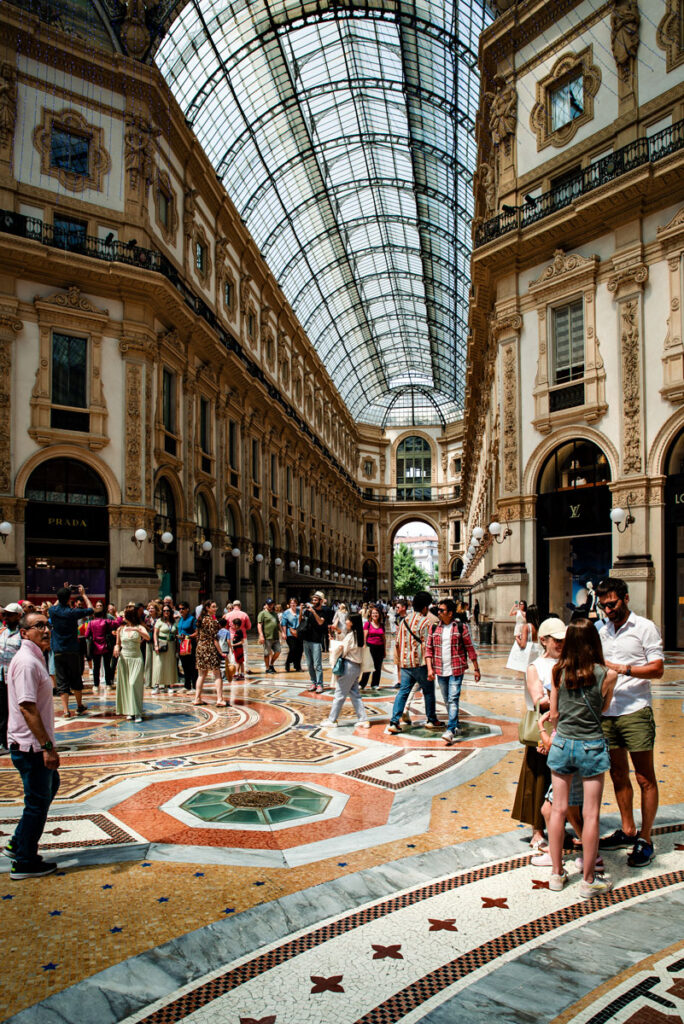MILAN
The region around Milan is considered one of the most important economic areas in Italy, if not Europe. Industries such as the automotive sector, the financial sector and, of course, the fashion world have brought prosperity and importance to the city.
A look at Italy’s traffic atlas underlines this impression. As an important commercial center and traffic hub, Milan is surrounded by a network of highways and suburbs. For most travelers from north-western Europe, Milan is probably the gateway to Italy.

The city’s main attraction is probably the Duomo di Milano. Masses of tourists crowd in front of it, construction sites and security barriers block the view of the imposing building. The queue to get in is hundreds of meters long. We decide to skip it and head straight on to the world-famous Galleria Vittorio Emanuele II shopping arcade. Luxury brand after luxury brand is lined up here. In the city itself, we keep coming across strikingly fashionably dressed people. Is this the face of the city or merely the equalizing consumer capitalism of our society?
We only admire the Castello Sforzesco from the outside – on such a beautiful early summer’s day, the tourists are also crowded here. We look for a quiet spot in the neighboring park and find a well-trodden meadow near a group of young people. We don’t understand their Italian, but we can guess that their conversations are about the big issues: the future, love and their dreams.


After half a day, Milan has made us tired. We stroll through the city for a while, looking for a café without touristy prices. At some point we give up the search and pay the price you pay in cities like Milan for two coffees, a scoop of ice cream and a cold beer.
As people pass by our table, we ask ourselves what a tourist has to do to really discover a city. Should he visit all the sights in his travel guide? Should he sit on a park bench for a day to people-watch? Or should he visit places that are not mentioned in the guidebook, places that seem authentic? In fact, are there any cities that you have to see?
One day in Milan is enough for us. It’s not our city. It is pretty, but we don’t recognize anything special about it. After thinking about it for a long time, we agree that it is the magic of a place that captivates every traveler or not. We decide for ourselves what is good for us and what we want to discover – not the travel book.
Exhausted and with the feeling that we have seen a lot but discovered nothing, we take the streetcar back to our campsite.
Info about our trip
One day in Milan is enough for an overview. If you are interested in fashion, Italy’s history or the city in general, plan at least three days. The city is quite touristy and you should therefore plan more time for everything and book tickets – where necessary and possible – online in advance. We recommend visiting in the low season.
You can quickly get rid of a lot of money in Milan. As an international financial and fashion center with a large number of tourists, prices are above average, although nowhere near as high as in the now “lifeless” tourist hotspots of Venice or Dubrovnik. Entrance fees for the cathedral, the castle or museums such as the Leonardo3 Museum (we have omitted all of these) can quickly add up to three-figure sums for two people.
Unfortunately, we don’t have any helpful tips for eating out in Milan. We had lunch in a fairly below-average Chinese restaurant and took a refreshment break in a rather expensive but mid-range café in the afternoon. So try your luck yourself!
We spent the evening and night camping in the southern outskirts of Milan at the Podere Ronchetto Agricampeggio e Agriturismo B&B. The free-range hens and ducks are great fun, certainly for children, and you can buy fresh Italian products for your self-cooked dinner in the farm store. Otherwise, the sites are simple and okay, the sanitary facilities are a little too poor when full and were not always clean during our stay. But a great campsite for one or two nights.
The Gratosoglio streetcar station is just a 10-minute walk away, from where you can be in Milan city center in around half an hour.
In Milan, we felt very safe.
We found Italians to be very child-friendly people. Whether we were in a restaurant or standing in line at the supermarket checkout, our then 8-month-old son was always greeted with a smile, and his occasional fussiness was always met with humor.
Regarding the child-friendliness of the facilities in restaurants and other stores, we had very different experiences. From fancy restaurants with no changing facilities to fully equipped changing rooms in the hinterland of Sardinia. Be prepared for anything.
Save yourself the trouble of driving into the city center. The best way to get around Milan and its suburbs is by streetcar, and everything in the city itself is within walking distance. There is also a metro.
